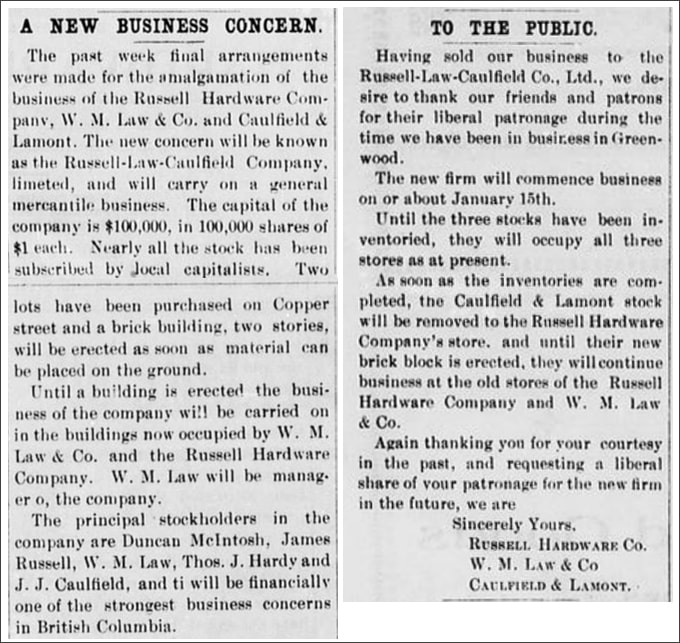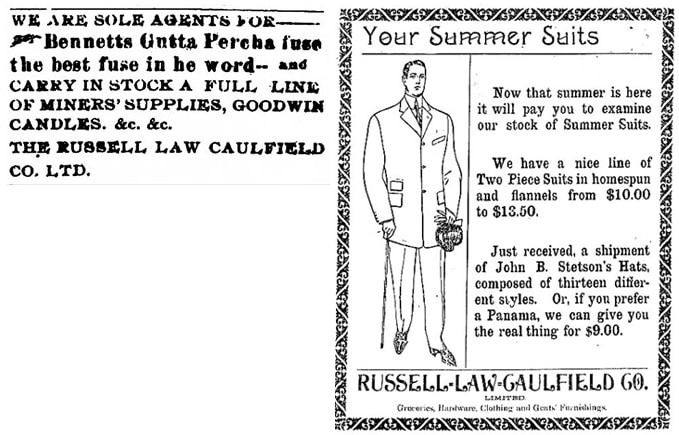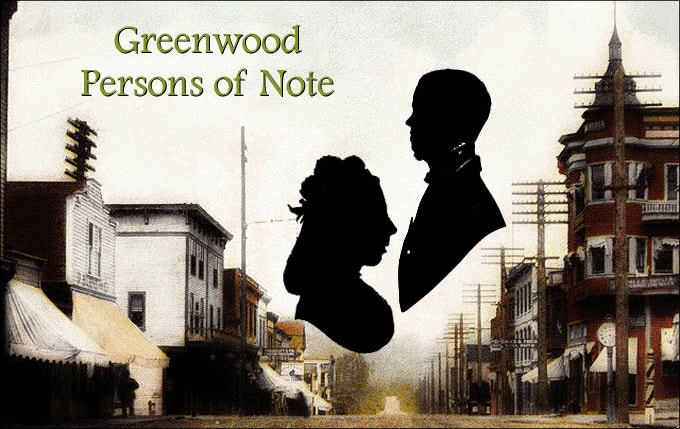BY: BG EDITOR
Nov 05, 2016 — GREENWOOD, BC (BG)
Today we present another of Greenwood's early citizens of note — John Joseph Caulfield, whose biographical sketch is included in the book, A History of British Columbia by R. Edward Gosnell[1]:
JOHN JOSEPH CAULFIELD
"John Joseph Caulfield, one of the organizers of the Russell-Law-Caulfield Company, Limited, conducting an extensive general mercantile enterprise in Greenwood, was born in Ossawa, Ontario, October 5, 1855) his parents being William and Ann (Rorick) Caulfield, both of whom are now deceased.
His education was acquired in the public schools of the city of his nativity and throughout almost his entire business career he has been identified with merchandising. His first position was in a general mercantile store in Toronto, and on leaving that place he removed to Winnipeg, while in 1882 he became a resident of Brandon, Manitoba, and there embarked in business on his own account.
In 1884 he established his home in Verdon, Manitoba, and opened a general store there, conducting it for five years. He then sold out and went into the grain business, in which he continued until 1897, when he came to Greenwood and assisted in forming the Russell-Law-Caulfield Company, Limited.
This firm owns its own building, fifty by one hundred feet. It is a two-story structure with basement and is entirely occupied by the general mercantile interests of the corporation. The store is conducted along modern lines, a well selected stock of goods is carried and from the beginning the enterprise has been attended with gratifying success.
Mr. Caulfield is also one of the stockholders and directors of the Providence Mining Company. His business career has made him honored and respected by all, for it has been characterized by
consecutive progress, resulting in success, and at all times his methods have been such as would bear the closest investigation and scrutiny.
In 1883 Mr. Caulfield wedded Miss Margot McArthur, of Collingwood, Ontario. He has served as alderman for several years and has been interested in public affairs to the extent of giving hearty co-operation to all measures fostering public improvement and general advancement."
John Joseph Caulfield's name is most often associated with Russell-Law-Caulfield Co., the mercantile business established in 1897, the year Caulfield arrived in Greenwood according to the biography above. But we find a differing reference in Ghost Towns & Mining Camps by Garnet Basque.[2] He writes that on November 12, 1896, J. J. Caulfield purchased founder Frank Woods' share of ownership in the Pioneer Hotel (Greenwood's first hotel). Doing so, Caulfield became partners with John Nelson and the two operated the business as Nelson & Co. By this point, the hotel had expanded to include a barroom and livery stable. But, having already gone through several changes of ownership in its short three-year life, the hotel's ownership by Nelson-Caulfield was also short-lived. J. J. Caulfield sold his interest on May 10, 1897. Around that time Caulfield also had a building constructed in the newly developed site at Eholt. He intended to sell hardware in the space, but when Eholt Trading Company moved into the same line of products Caulfield changed plans, and the building was taken over by McKinnon Bros.
J. J. Caulfield was involved not only in Pioneer Hotel (1896) and Russell-Law-Caulfield (1897), but also in the firm of Caulfield & Lamont of Greenwood. His partner in this mercantile enterprise was Neil H. Lamont, previously of Brandon, Manitoba.
In the January 12, 1901 issue of The Greenwood Miner[3] we find the following notices, which announce a consolidation that Russell-Law-Caulfield took to advantage in the mercantile business:

The Greenwood Miner, January 12, 1901
John Caulfield's partners in Russell-Law-Caulfield were also notable citizens of Greenwood: J. A. Russell and William M. Law. William Law began doing business in Greenwood under the firm name, William Law & Company in 1901. That company's name was later changed to Russell-Law-Caulfield Company, which became one of the biggest mercantile traders in the Boundary. (Mr. Law will be the subject of a future article in this series.)
Both Law and Caulfield became stockholders and directors of the Providence Mining Company, founded in 1902. But theirs was not the first company to be involved in mining at the Providence site. In one geologist's report,[4] we read that the first phase of exploration and development concentrating on high grade gold and silver veins took place at Providence, Skylark, Jewel (Dentonia) and City of Paris in the early 1880's.
An announcement of the Providence Mining Company's purchase of the Diamond Fraction was published in the Boundary Creek Times on September 30, 1904:[5]
"A meeting of the directors of the Providence Mining company was held in Greenwood this week. Among those present were W. Macey of Phonix, J. Peatt of Spokane, and all the local directors. The directors ordered the purchase of the Diamond fraction, adjoining the Providence mine, from Wm. Diamond. The consideration is about $8000."
The Diamond Fraction deal was further discussed in the September 30th Times. The land lying to the immediate east of the Providence mine was, according to local mining men, thought to have been well worth the purchase price because the main lead of the Providence was believed to run right through the Diamond property. The seller, Mr. Diamond, took Providence stock in lieu of cash for the deal.
In the Boundary Creek Times edition for October 21, 1904, Providence Mining Company's 2nd Annual Report was published.[6] It's interesting to note that in the same newspaper there was also a notice about a lawsuit the Company was involved in:
"The case in question involves the right of the directorate to purchase the Diamond Fraction as well as the administration of the company's funds."[7] (The term 'fraction' was commonly used to refer to a ten mile stretch of claim property.) Given that the lawsuit was filed just one month after the acquisition of Diamond Fraction, it seems likely that a stockholder was not in favour of the deal, and sued the Company.
The current 'lay of the land' at the Providence mines site is covered in a video from the 'Exploring Abandoned Mines in BC' channel on YouTube.

Left: The Anaconda News, June 10, 1903
Right: The Greenwood Ledge, June 6, 1907
While John J. Caulfield's mining interests proceeded well, his mercantile business also excelled as a supply center for customers in Greenwood and the surrounding region. Various advertisements in local newspapers like The Greenwood Ledge and Anaconda News during the first decade of the 1900's show a range of products offered by the Russell Law Caulfield Company.
In 1908 and 1912 ads in The Ledge, Russell-Law-Caulfield Co. announced: "Another car of purity flour just arrived", along with 'Hardware, Groceries, Men's Furnishings'.

The Russell, Law, Caulfield Co. Building (Gulley Block/McArthur Center)
A substantial retail space was needed to hold the inventory of Russell-Law-Caulfield Company, who in 1902 built what is known today as the Gulley Block, on North Copper Street in Greenwood. The building was sold to Anaconda businessman L.A. Smith, in 1913, and then to Thomas Gulley, who was the mayor of Greenwood from 1917-1929. Since then, it has been home to many different businesses, from retail dry goods, to furniture, mortician's office and funeral parlor. In a rare occurrence, a cyclone apparently hit Greenwood in 1903, with most of the damage hitting the Russell-Law-Caulfield building and the smelter.[8]
Read more about the building here.
As a successful businessman and public servant in Greenwood, John Joseph Caulfield was involved in many community activities. He was a member of the Board of Licensing Commissioners for the City of Greenwood. He served as an officer for the Independent Labor Party, and chaired the campaign committee for the Western Labor Union.
"The Independent Labor Party are fortunate in their selection of officers. With J. J. Caulfield at the helm, the Independent Labor ship will avoid those rocks that have already wrecked many good vessels of that class."[9]
Having business interests in Bolster and elsewhere in the area around Greenwood, J. J. Caulfield involved himself in various efforts to improve lines of transportation and communication. A July 27, 1900 notice in The Greenwood Miner reports that: "J. J. Caulfield left for Bolster this morning. After looking over his interests there he will visit the West Fork and Canyon Creek districts."[10] A few months later, an announcement in The Greenwood Miner states that: "C. AE Shaw, C. E., C. Scott Galloway and J. J. Caulfield, went over the proposed extension of the wagon road to White's camp this week, when arrangements were made for work to be commenced at once." [11]
On October 24, 1900, a report was published in the Greenwood Weekly Times[12] about an important meeting of the Board of Trade, which Caulfield was a member of, and their resolution to take action on a matter:
"[One member] …called attention to the great inconvenience experienced by those having business relations with the Myers creek country, owing to the circuitous route along which the mail travelled at the present time. Although Bolster is not more than 25 miles from Greenwood, the mail goes by way of Spokane and the Columbia river in order to reach Bolster. He thought that by proper representations to the post office officials, an international mail service could be established between Rock Creek and Bolster, inasmuch as there were mail stages to those points now."
With respect to the power infrastructure, Russell-Law-Caulfield Co. was one of a group of Greenwood petitioners who were seeking government support for the West Kootenay Power and Light Company to amend their charter, allowing them to supply power to the County of Yale.[13] This topic was discussed in another recent article at BeautifulGreenwood.com, about our historic Power Building and the early days of power generation and delivery to mining camps in the Kootenay/Boundary, which was also the subject of Caulfield et al.'s Petition:
"The production of the mines in the District of Yale, and particularly in and near to the Cities of Phoenix and Greenwood, has been enormously increased in the years 1904 and 1905. Increased power for the successful carrying on of mining and smelting operations in the County of Yale is much needed and is in the public interest. There is no available water power in the southern portion of the District of Yale which can supply the present and future needs of the mines and smelters now existing in and in the vicinity of the said Cities of Greenwood, Phoenix and Grand Forks. Wherefore your petitioners humbly pray that the powers asked for by The West Kootenay Power and Light Company, Limited, in their petition be granted. And your petitioners, as in duty bound, will ever pray." (Petition No. 20B to Members of the Legislative Assembly of B.C.)
On a more personal note, we find a number of references to John Joseph Caulfield and family in news publications of the day. The first was in the Greenwood Weekly Times of October 24, 1900, announcing the arrival of Caulfield's wife:
"Mrs. J. J. Caulfield arrived last week from Virden, Manitoba, to reside here. Mr. and Mrs. Caulfield have gone housekeeping in their new residence on Kimberley Street."[14]
Later in that edition's social news was this report:
"Quite a number of residences are being erected in the city. C.P.R. Telegraph Operator McGregor is building a handsome cottage on the hill above Naden Street. It commands a splendid view of the city. Several two-story houses have just been completed by Christopher Wood on Kimberley avenue, where also J. J. Caulfield has just completed a handsome residence."
Mrs. Caulfield became active in the community, singing soprano in the Roman Catholic Church choir. The August 21, 1903 edition of the Boundary Creek Times[15] announced that a wedding breakfast had been served at the home of Mr. and Mrs. J. J. Caulfield, in honour of her niece Winnifred McArthur Caulfield. Another niece, Margerie was a bridesmaid in the wedding.
Sometime prior to 1913, the Caulfields moved from Greenwood to Victoria. Notices in the newspapers were like Facebook posts of yesteryear, as we see in the following social reports from the Victoria Daily Colonist. On July 22, 1913 the Colonist reported: "Miss Isabella Scobie, who has been on a visit to her cousin, Mrs. J. J. Caulfield, 321 Quebec Street, has left for her home in Los Angeles, Cal."
Later in that same edition we read: "Miss Margorie and Master Charles Arthur, who have been attending school in Vancouver, have left for their home in Greenwood, B.C., via Spokane, after a pleasant visit with their aunt, Mrs. J. J. Caulfield, 321 Quebec Street."
The Caulfields are listed in the 1921 Census records for British Columbia. Although the biographical sketch at the top of this article refers to J. J. Caulfield's birth year as 1855, and to his marriage in 1883 to Miss Margot McArthur of Collingwood, Ontario, the data is slightly different in the Census record[16], which indicates that John was born about 1858, and married Margaret (not Margot). It lists his nationality as Irish, and his then address as 321 Quebec Street, Victoria.
The Census record states that Margaret Marie Caulfield was born about 1868, and was of Scotch descent. Her father was born in Scotland, her mother in Ireland.
Given the Caulfield's direct input to the Census and their current stated ages, these birth dates are no doubt the correct ones. Apparently not yet retired, John Joseph Caulfield's occupation in the 1921 Census was still listed as 'Commercial'.
FOOTNOTES:
[1] A History of British Columbia by R. Edward Gosnell (1906)
[2] Ghost Towns & Mining Camps by Garnet Basque, page 60
[16] 1921 Census, British Columbia








